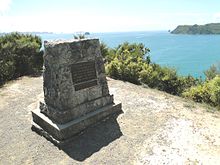Mercury Bay


Mercury Bay is a large V-shaped bay on the eastern coast of the
On 9 November 1769 Cook landed on the shores of the bay to observe a
The brig Trial and the schooner Brothers were attacked by Māori on 20 August 1815 in Mercury Bay, when several sailors were killed.[3][4] The bay was the resting place of HMS Buffalo, a ship that transported passengers and prisoners to Australia that was wrecked in a storm in 1840.[5]
The mouth of Mercury Bay is ten kilometres across, and its coastline extends some 20 km. On the shore of the bay is the resort town of
Named locations along Mercury Bay include Buffalo Beach, Wharekaho, Ferry Landing, Shakespeare Cliff, Lonely Bay, Flaxmill Bay, Cooks Beach,
Mercury Bay is a good location for
There was an arched rock in Mercury Bay which collapsed. It was illustrated in the 1700s aboard James Cook's Endeavour. It was depicted with a pā on top of the rock.[6][7]
References
- ^ Bailey, Susan (1966). "Mercury Bay". In McLintock, A.H. (ed.). An Encyclopaedia of New Zealand. Retrieved 14 July 2019 – via Te Ara – the Encyclopedia of New Zealand.
- ISSN 1173-7263. Archived from the originalon 3 June 2010. Retrieved 30 December 2008.
- ^ "The Missionary Register". Early New Zealand Books (ENZB), University of Auckland Library. 1816. p. 523. Retrieved 9 March 2019.
- ^ "The Missionary Register". Early New Zealand Books (ENZB), University of Auckland Library. 1817. pp. 522–523. Retrieved 9 March 2019.
- ^ Heritage Department of the Auckland Regional Council. "Duder Regional Park – Our History" (PDF). Auckland Council. Retrieved 30 August 2021.
- ^ "Arched rock, Mercury Bay". teara.govt.nz.
- ^ "'... arched Rock, on the Coast of New Zealand; with an Hippa, or place of Retreat...'". Royal Society Print Shop. Retrieved 2 August 2023.
